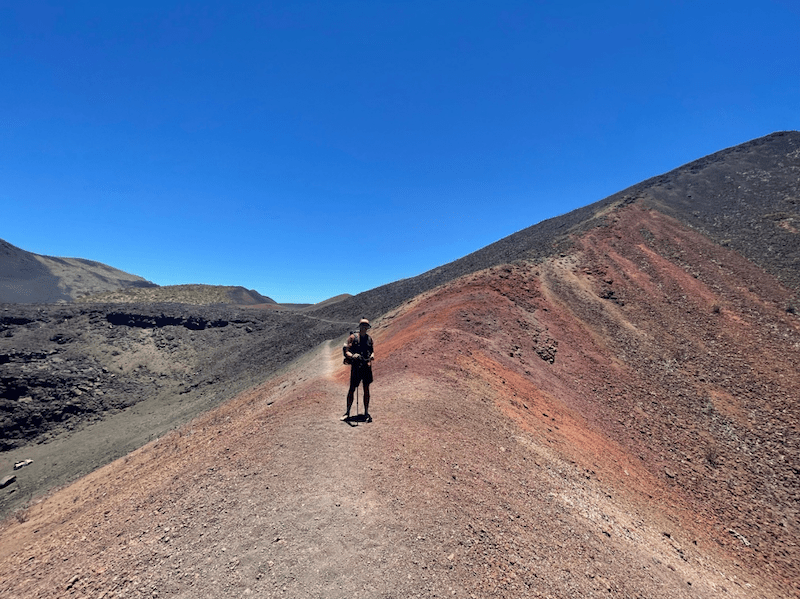Three Days in the Crater
Written by: Jacob Hakim

In between work on the oral histories project and working on the front line with the rest of the interpretive team, I was lucky enough to tag along for three days of backcountry operations alongside Ranger Laurel, one of our team leads. We had several goals:
- Replace outdated signage in the display case by Palikū cabin, and clean the display case glass;
- Check the combinations on the wood lockers in Palikū cabin to make sure they matched the combinations to be given out to visitors;
- Photograph the signs marking the tent sites at the Hōlua campgrounds;
- Hike the backcountry trails for better interpretation for visitors.
I was especially excited for the trip since all backcountry areas, including all trails and campgrounds, were closed during my 2020 CRDIP term in the park. Since then, hiking trails had opened up, and tent camping reservations opened just before I moved to Maui for this year’s position. I would finally get to use my camping gear and spend a night under the stars in the vast, quiet desert of the crater. (I actually spent my first night in the crater a few weeks before our work trip – I hiked down to Hōlua after a sunrise shift and camped there, but this would be my first time out to Palikū and my first ever multi-night backpacking trip.)

With some borrowed hiking poles in hand and a heavy, full pack on my back, I set off alongside Laurel from the summit trailhead of Keoneheʻeheʻe. It was a windy morning, and after a few minutes on the trail, we paused to chant “E hō mai,” a Hawaiian oli (chant) that is traditionally done to ask for wisdom and guidance at the start of an undertaking. After finishing the oli and listening to the wind, we pressed on, down and down until we reached the first junction where the trail breaks off toward Hōlua.

After a quick break, we continued on, noting the change in landscape. We stopped again to rest at Kapalaoa Cabin, one of the three visitor cabins, and then continued until we reached Palikū. In total, we hiked more than 9 miles, with more than 3,000 feet of downward elevation change. We met a few maintenance rangers who were working on Palikū cabin (which has yet to reopen because of water shortage issues) and spent the evening fixing up the display case and talking story. The night was clear and totally silent, and the stars were bright and many.

The next morning we woke up and walked to inspect a landslide that happened a few months ago in the back of the valley. After heading back to camp and getting our gear, we set off on the trail, quickly hitting new ground as we took a right turn towards Hōlua campground (the back way). This route was hard and hot. We traversed treacherous uphill ʻaʻā lava flows, taking care with each step, under the constant glare of the sun. The trail was totally exposed, but we made good time. We stopped to take a break and peer down Kawilinau, once known as “The Bottomless Pit,” a 65 foot deep lava pit on the side of one of the cinder cones. The terrain in this region of the crater resembles the moon or mars – sparsely populated by greenery, there is red and black sand in all directions. We finally reached Hōlua in the early afternoon, photographed the tent signs, checked the wood lockers, and ate lunch in the shade of the ranger cabin. This leg of the trip was six and a half miles, with 600 feet of net elevation gain (but lots of up and down along the way).

After we set up camp, ate dinner and watched the sunset, the sky shifting through a magnificent range of colors visible through the Koʻolau gap, I lay in my tent looking up at the stars thinking, Where am I? How did I get here? I dozed off as the milky way swirled overhead, the otherworldly sounds of the nocturnal ʻuaʻu or Hawaiian petrel (pterodroma sandwichensis) echoing off the crater ridge walls and filling my ears. As I woke, packed, and hiked out through the Halemauʻu trail the next day, I felt a part of me left behind at the crater floor, a connection to the ʻāina (land) that I want to share with park visitors more than ever before.

To learn about a career in conservation and preservation, visit ACE online today.
